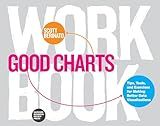Best Data Visualization Tools to Buy in December 2025

Data Visualization with Microsoft Power BI: How to Design Savvy Dashboards



Fundamentals of Data Visualization: A Primer on Making Informative and Compelling Figures



Data Visualization with Excel Dashboards and Reports



Good Charts Workbook: Tips, Tools, and Exercises for Making Better Data Visualizations



Data Points: Visualization That Means Something



Storytelling with Data: A Data Visualization Guide for Business Professionals, 10th Anniversary Edition



Business Intelligence Essentials You Always Wanted to Know: A Beginner’s Guide to BI Tools, Data Analytics Techniques, Data Visualization & Data-Driven Strategy (Self-Learning Management Series)



Good Charts, Updated and Expanded: The HBR Guide to Making Smarter, More Persuasive Data Visualizations



Data Analytics, Data Visualization & Communicating Data: 3 books in 1: Learn the Processes of Data Analytics and Data Science, Create Engaging Data ... Present Data Effectively (All Things Data)


To create line charts using D3.js, follow these steps:
- Set up the HTML structure: Start by creating an HTML file and add an SVG container element within the body tag. This container will hold the line chart.
- Include D3.js library: Add a script tag to include the D3.js library in the HTML file. You can link to a locally downloaded copy or use a CDN.
- Load or generate data: Define or load the data that you want to visualize as a line chart. Make sure the data is in the proper format, such as an array of objects or a two-dimensional array.
- Set chart dimensions and margins: Determine the width and height of the line chart and set margin values for spacing around the chart. These dimensions will define the size of the SVG container and the plot area within it.
- Create scales: Create scales to map your data values to the chart dimensions. For the x-axis, use D3's scaleLinear or scaleTime, depending on the data type. For the y-axis, use scaleLinear to map data values to the chart height.
- Define line generator: Use D3's line generator function to convert data values into SVG path commands that create the lines. Configure the generator by setting x and y accessors based on your data structure.
- Append path elements: Add path elements to the SVG container using the data and line generator. Set the "d" attribute of the path to the line generator output to draw the lines based on the data points.
- Add axes: Create x and y axes using D3's axis generator functions. Configure the axes with scale, tick formatting, and positioning options. Append the axes to the SVG container using the "g" element.
- Optional: Add labels and titles: Add labels for the x and y axes and a title for the chart to provide additional context and clarity. Use D3's text or title elements to achieve this.
- Style the chart: Customize the appearance of the chart by applying CSS styles to the SVG container and its child elements. Modify attributes like stroke, fill, font-size, etc., to match your desired design.
- Data updates and interactions: If you want to enable data updates or interactions with the chart, set up event listeners to handle interactions such as clicks or hover effects. You can also update the chart dynamically by binding new data and updating the path elements based on the updated data.
By following these steps, you can create line charts using D3.js to visualize your data in a visually appealing and interactive manner.
What are the different ways to handle data updates in D3.js line charts?
There are several ways to handle data updates in D3.js line charts. Here are a few approaches:
- Update the entire chart: In this approach, you remove the existing chart from the DOM, update the data, and redraw the entire chart with the updated data. This ensures that the chart is always accurate, but can be resource-intensive if the chart is complex or has a large amount of data.
- Transition the changes: D3.js provides methods for smooth transitions between different states of the chart. You can use these transition methods to animate changes in the line chart when the data is updated. This approach provides a visually appealing way to show updates but may require additional code to handle data append and removal efficiently.
- Update specific elements: Instead of recreating the entire chart, you can update specific elements, such as the line, axis, or labels, based on the updated data. This approach is more efficient than redrawing the entire chart and can enhance performance.
- Use data binding: D3.js provides robust data binding capabilities that allow you to bind data to DOM elements. When the data is updated, you can modify the bound data and let D3.js automatically update the corresponding elements in the chart.
The approach you choose depends on the complexity of your chart, the amount of data, and the specific requirements of your application. Consider the trade-offs between accuracy, performance, and visual appearance when deciding how to handle data updates in your D3.js line charts.
What are the necessary steps to draw a line chart in D3.js?
To draw a line chart in D3.js, you need to follow these necessary steps:
- Include D3.js library in your HTML file by adding the following script tag:
- Create an SVG element to hold the chart. Append an SVG element to a DOM element in your HTML file using D3's select and append methods. For example: const svg = d3.select("#chart-container") .append("svg") .attr("width", width) .attr("height", height);
- Define the data for the line chart. Typically, this data will be an array of objects, where each object represents a data point. Each object should have properties for x and y values. For example: const data = [ { x: 1, y: 10 }, { x: 2, y: 15 }, { x: 3, y: 7 }, { x: 4, y: 20 }, { x: 5, y: 12 } ];
- Define scales for the x and y axes. Use D3's scale functions to convert your data values to coordinates on the SVG canvas. For example: const xScale = d3.scaleLinear() .domain([0, d3.max(data, d => d.x)]) .range([0, width]); const yScale = d3.scaleLinear() .domain([0, d3.max(data, d => d.y)]) .range([height, 0]);
- Create a line generator function. Use D3's line function to generate the path coordinates for your line. The line generator should be configured with x and y accessors that specify how to retrieve the x and y values from your data. For example: const line = d3.line() .x(d => xScale(d.x)) .y(d => yScale(d.y));
- Append a path element to the SVG to represent the line chart. Bind your data to the path element using D3's data method, then define the path's "d" attribute using the line generator. For example: svg.append("path") .datum(data) .attr("d", line) .attr("fill", "none") .attr("stroke", "steelblue");
- Append x and y axes to the SVG. Use D3's axis functions to create the axes, then append them to the SVG. For example: const xAxis = d3.axisBottom(xScale); const yAxis = d3.axisLeft(yScale); svg.append("g") .attr("transform", `translate(0, ${height})`) .call(xAxis); svg.append("g") .call(yAxis);
- Style and customize your chart as desired using CSS.
With these steps, you should be able to draw a basic line chart using D3.js. Remember to adjust the dimensions of your SVG according to your desired chart size and margins.
What are the best practices for optimizing D3.js line charts?
Here are some best practices for optimizing D3.js line charts:
- Use data joins: D3.js encourages the use of data joins to efficiently update the chart. When updating the chart with new data, bind the data to the elements and use the enter, update, and exit selections to efficiently handle additions, updates, and removals of data points.
- Minimize DOM manipulation: Manipulating the DOM can be expensive, so it's a good practice to minimize it. Instead of creating separate SVG elements for each data point, consider using paths or lines to represent the lines in the line chart. This reduces the number of elements and enhances performance.
- Use throttling or debouncing: If your chart has interactive features like tooltips or zooming, consider using throttling or debouncing techniques to limit the frequency of events being triggered. This prevents excessive redraws and ensures smooth performance.
- Use appropriate scales: Choose the appropriate scales for your data. D3 provides various scale functions like linear, logarithmic, time, etc. Depending on the data range and distribution, select the scale that best represents your data and helps in visualizing it effectively.
- Use efficient transitions: D3 provides transition capabilities, which can be used to animate changes in the chart. Utilize these transitions wisely to enhance user experience and provide smooth visual updates without affecting performance.
- Optimize for responsiveness: Ensure that your chart responds well to resizing or changes in the viewport size. Use D3's responsiveness features like viewBox and resize event listeners to adapt the chart to different screen sizes or device orientations.
- Use SVG gradients sparingly: SVG gradients can impact performance, especially if there are multiple elements using gradients in the chart. Use them sparingly and consider alternative options, like solid colors or patterns, when possible.
- Consider data preprocessing: If your data has a large number of points, consider preprocessin
